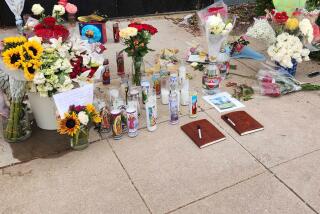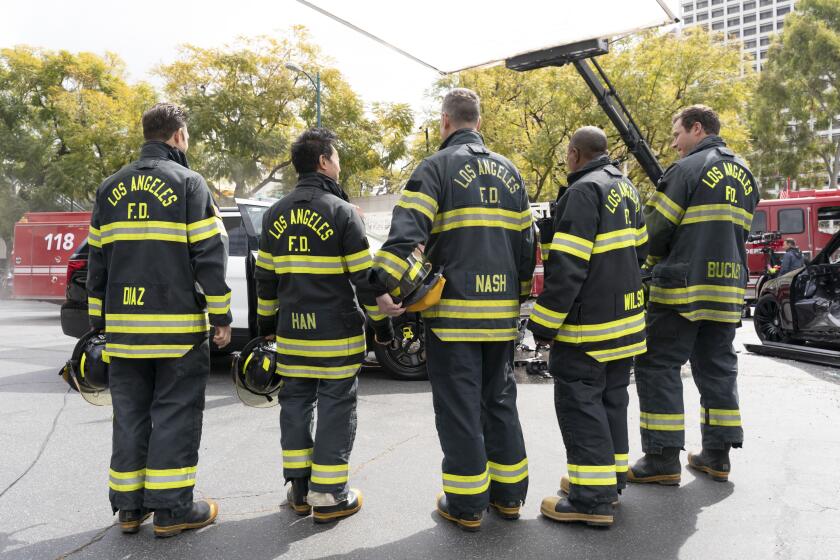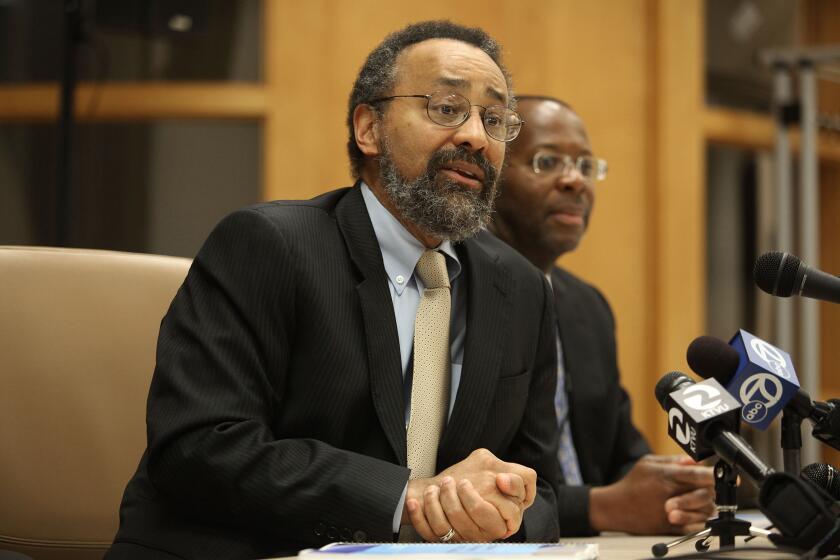Medical ‘Open Door’ : Busy Emergency Center Lacks Payments, Not Patients
It is 9 p.m. at California Medical Center’s emergency department as Dr. Randall Sword arrives for the late-night shift. He faces a sea of faces in the waiting room. All 13 beds are occupied, and so are two gurneys in the hallway.
He throws open the doors to the brisk night air and counts four ambulances, two police cars and a police motorcycle. “Look,” he says. “Here comes a fire truck!”
It is one of the busiest private emergency rooms in the county--”an open door to the masses of central Los Angeles,” as a hospital spokesperson put it.
But because of substantial financial losses, hospital officials are seriously considering drastic curtailment of the emergency room. About 60% of the patients who visit the emergency room have no money to pay their medical bills, said Dr. Alan Heilpern, who is in charge of the emergency room doctors. But these patients cannot, by law, be turned away until they are treated and stabilized.
The shock waves of closing or downgrading the hospital’s busy 24-hour emergency room would be felt in other emergency facilities throughout the county, which would be forced to pick up the slack. But nobody would feel it more than the people who, on any given day or night, seek care there.
Ambulances bring between 25 and 41 people a day to California Medical Center’s emergency room at 1414 S. Hope St. just a few blocks from freeway overpasses that crisscross downtown Los Angeles. Dozens more patients come on their own.
Sword, in his mid-40s, is swamped before he even gets started.
He begins with a quick survey, noting a sick 1-month-old infant, a 51-year-old woman with pelvic pains, two boys with scalp lacerations who were “hit over the head with a pipe by a crazy man.”
Before he gets any farther, the doctor is alerted to a young man with a severe muscle spasm that has frozen his face into a monstrous expression and seems to fuse the left side of his head to his left shoulder. He cannot talk and can barely breathe. Sword prescribes an injection.
Meanwhile, there is commotion in a room marked “major trauma,” meaning there is supposed to be one nurse for each of the two patients. But tonight there is only one nurse.
In one bed, an 11-month old boy lies naked and delirious, breathing huge bubbles of mucus from his nostrils. The child will lie there undisturbed for the next hour when he will be roused suddenly by a technician drawing blood from his tiny fingertip. Later, the other doctor on duty will insert a three-inch needle into his lower spine to draw fluid for analysis.
In the other bed, a heavyset 45-year-old man is in agony. “He’s having a heart attack right now,” Sword announces. As he calls for some tests and a cardiologist, another ambulance pulls up and wheels in a victim of an automobile accident.
“They brought another one, and there’s not even a bed for him,” Sword declares. A paramedic says apologetically that he was directed here by dispatchers.
The system for dispatching paramedics is poor, Sword says. Six different rescue units from the Los Angeles City Fire Department regularly discharge patients at California Medical Center at the direction of dispatcher stations whose activities are not well coordinated. “We’ve got no control over the situation,” Sword says.
Sword heads off to treat the infant with a cough. Reassuring himself that the baby is probably OK, he heads back to check on the heart attack victim who keeps rubbing his chest and says through clenched teeth, “My whole arm is throbbing!”
Sword prescribes more morphine and dashes over to a phone to arrange for special treatment that will attempt to dissolve a clot in the man’s arteries.
Then he heads off to check on a woman--six months’ pregnant--who is weak from vomiting.
Meanwhile, in the corridor a child who had fallen down a stairwell is now finally on his way to a hospital bed upstairs. His parents and a family friend are hovering around the gurney, complaining that they have had to wait three hours.
It is 9:30 p.m., and the head nurse says she has informed dispatchers that the emergency room is saturated and ambulances should be diverted elsewhere. But this will not really keep them away, Sword says. And it certainly will not prevent people from arriving on their own.
Beat Up by Youths
Sword heads down the hall to treat a 13-year-old girl who was brought in by police after she ran away from her foster home and was beat up by some neighborhood youths.
It was the second day in a row that she says the boys kicked her to the ground and stomped on her head. She points to the handcuffs that hold her wrist to the hospital bed railing and asks the nurse what this means. The nurse explains that since she ran away from her foster home, she has to be handcuffed to prevent her from fleeing.
Sitting next to her on a chair is the young man whose muscle spasm has been relaxed by a recent injection. There is no bed for him so he sits there listening to Sword quiz the runaway. He seems fine now but will have to wait until after midnight to finally get his discharge papers.
In the hustle and bustle of the corridor outside, a nurse is heard exhorting: “Gotta keep moving. Get your roller skates.”
A 20-year-old man dripping blood from his bullet holes has just staggered through the emergency room entrance where paramedics usually bring their gurneys. Friends drove him to the hospital after he was hit by gunfire from a passing car as he stood in front of his South-Central Los Angeles home.
Sword swings into action, preparing a bed in the major trauma room that had just been vacated by the heart attack victim. “How many kinds of guns were there? Was it more than one kind of gun? Did it sound like da-da-da-da-da or bang bang bang?” He turns away and announces, “This is gangland in action.”
A chest X-ray shows he was punctured twice. A pool of blood is collecting in the lung area that will have to be drained. Sword calls in a surgical resident and moves on to examine the 51-year-old woman with pelvic pain.
He has no explanation for her pain and sends her urine sample off for analysis. Then he moves on to check a young woman with a bone-baring gash on her wrist and a baby in her arms. The woman says her husband got drunk and came after her with a razor.
Sword sews her up, something he has done so often that it seems he could do it in his sleep.
‘The Adventure’
As he works, he explains, “This is what emergency medicine doctors love--the adventure, the electricity. Who knows what’s going to be coming through those doors: a child that can’t breathe, a guy shot in the chest or a pregnant lady losing her baby?”
He is paid $60 an hour by Heilpern, the doctor who heads the group of physicians that contracts with the hospital to provide emergency medicine. He has flexible hours, no overhead, no nurses to hire or union headaches. “Where else can you do that?” he points out.
But the stress and frustration of the workplace have clearly taken their toll.
While he once worked 50 hours a week in the emergency room, he has cut back to about 15 hours.
And if the emergency room closes--as some hospital officials fear it may have to--Sword will find something else to do.
He has recently opened up a private practice in Torrance with a new speciality: hair transplants.
More to Read
Start your day right
Sign up for Essential California for news, features and recommendations from the L.A. Times and beyond in your inbox six days a week.
You may occasionally receive promotional content from the Los Angeles Times.






